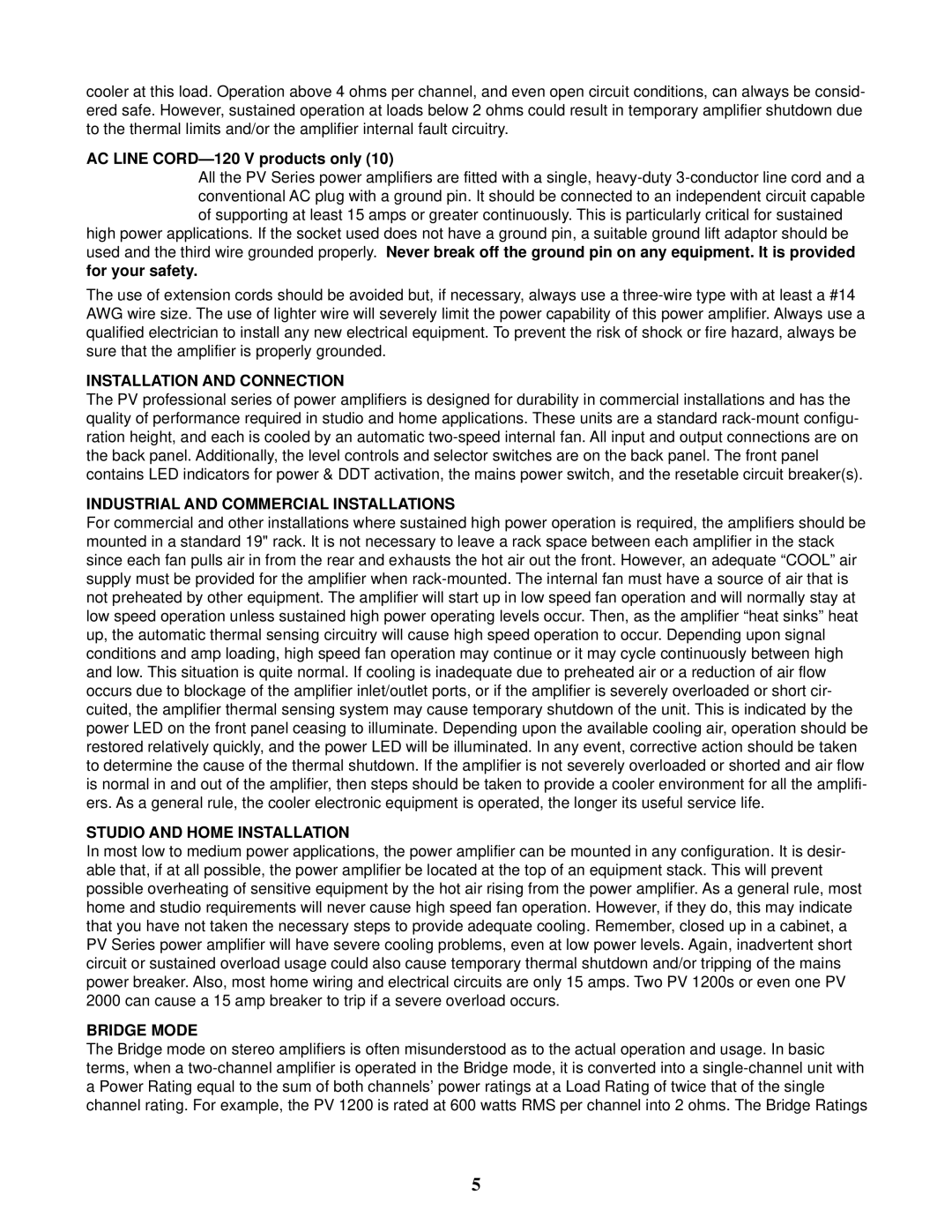cooler at this load. Operation above 4 ohms per channel, and even open circuit conditions, can always be consid- ered safe. However, sustained operation at loads below 2 ohms could result in temporary amplifier shutdown due to the thermal limits and/or the amplifier internal fault circuitry.
AC LINE CORD—120 V products only (10)
All the PV Series power amplifiers are fitted with a single, heavy-duty 3-conductor line cord and a conventional AC plug with a ground pin. It should be connected to an independent circuit capable of supporting at least 15 amps or greater continuously. This is particularly critical for sustained
high power applications. If the socket used does not have a ground pin, a suitable ground lift adaptor should be used and the third wire grounded properly. Never break off the ground pin on any equipment. It is provided for your safety.
The use of extension cords should be avoided but, if necessary, always use a three-wire type with at least a #14 AWG wire size. The use of lighter wire will severely limit the power capability of this power amplifier. Always use a qualified electrician to install any new electrical equipment. To prevent the risk of shock or fire hazard, always be sure that the amplifier is properly grounded.
INSTALLATION AND CONNECTION
The PV professional series of power amplifiers is designed for durability in commercial installations and has the quality of performance required in studio and home applications. These units are a standard rack-mount configu- ration height, and each is cooled by an automatic two-speed internal fan. All input and output connections are on the back panel. Additionally, the level controls and selector switches are on the back panel. The front panel contains LED indicators for power & DDT activation, the mains power switch, and the resetable circuit breaker(s).
INDUSTRIAL AND COMMERCIAL INSTALLATIONS
For commercial and other installations where sustained high power operation is required, the amplifiers should be mounted in a standard 19" rack. It is not necessary to leave a rack space between each amplifier in the stack since each fan pulls air in from the rear and exhausts the hot air out the front. However, an adequate “COOL” air supply must be provided for the amplifier when rack-mounted. The internal fan must have a source of air that is not preheated by other equipment. The amplifier will start up in low speed fan operation and will normally stay at low speed operation unless sustained high power operating levels occur. Then, as the amplifier “heat sinks” heat up, the automatic thermal sensing circuitry will cause high speed operation to occur. Depending upon signal conditions and amp loading, high speed fan operation may continue or it may cycle continuously between high and low. This situation is quite normal. If cooling is inadequate due to preheated air or a reduction of air flow occurs due to blockage of the amplifier inlet/outlet ports, or if the amplifier is severely overloaded or short cir- cuited, the amplifier thermal sensing system may cause temporary shutdown of the unit. This is indicated by the power LED on the front panel ceasing to illuminate. Depending upon the available cooling air, operation should be restored relatively quickly, and the power LED will be illuminated. In any event, corrective action should be taken to determine the cause of the thermal shutdown. If the amplifier is not severely overloaded or shorted and air flow is normal in and out of the amplifier, then steps should be taken to provide a cooler environment for all the amplifi- ers. As a general rule, the cooler electronic equipment is operated, the longer its useful service life.
STUDIO AND HOME INSTALLATION
In most low to medium power applications, the power amplifier can be mounted in any configuration. It is desir- able that, if at all possible, the power amplifier be located at the top of an equipment stack. This will prevent possible overheating of sensitive equipment by the hot air rising from the power amplifier. As a general rule, most home and studio requirements will never cause high speed fan operation. However, if they do, this may indicate that you have not taken the necessary steps to provide adequate cooling. Remember, closed up in a cabinet, a PV Series power amplifier will have severe cooling problems, even at low power levels. Again, inadvertent short circuit or sustained overload usage could also cause temporary thermal shutdown and/or tripping of the mains power breaker. Also, most home wiring and electrical circuits are only 15 amps. Two PV 1200s or even one PV 2000 can cause a 15 amp breaker to trip if a severe overload occurs.
BRIDGE MODE
The Bridge mode on stereo amplifiers is often misunderstood as to the actual operation and usage. In basic terms, when a two-channel amplifier is operated in the Bridge mode, it is converted into a single-channel unit with a Power Rating equal to the sum of both channels’ power ratings at a Load Rating of twice that of the single channel rating. For example, the PV 1200 is rated at 600 watts RMS per channel into 2 ohms. The Bridge Ratings

